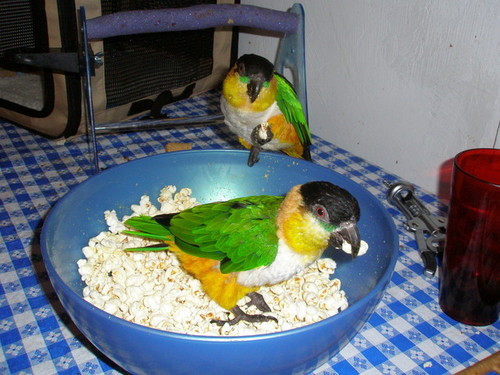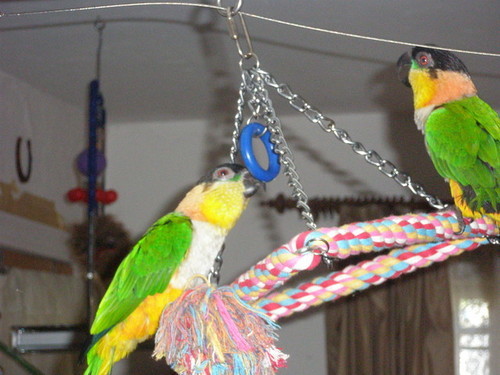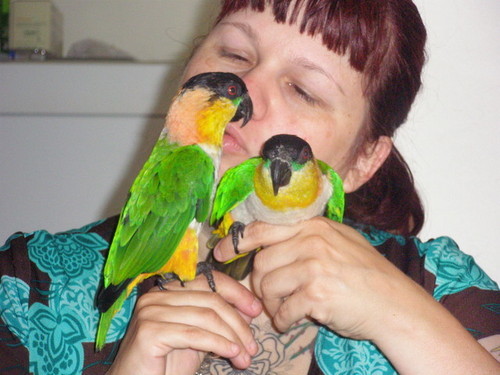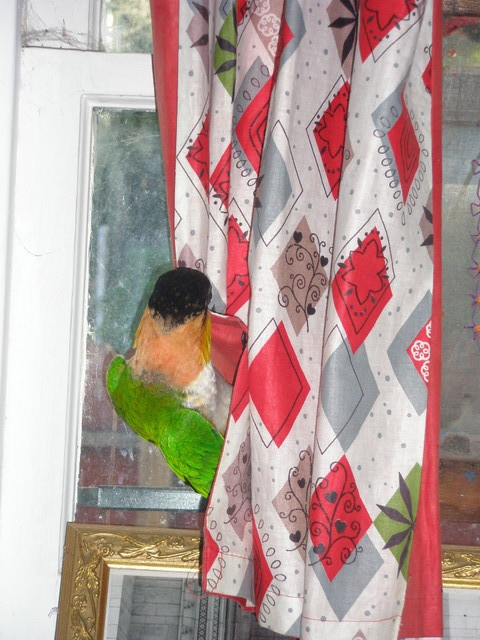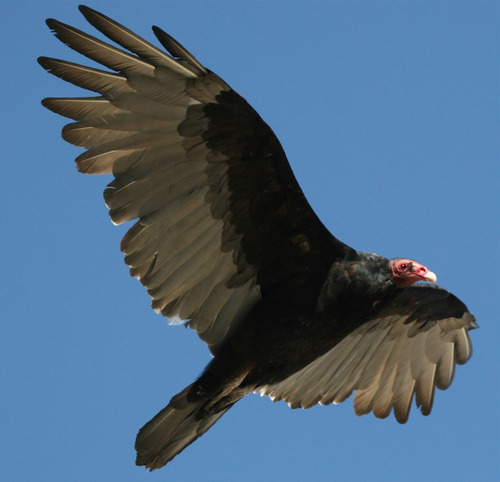For homes where birds and plants are to coexist, knowing which plants are considered bird safe is a must. The Shopper’s Guide to Bird-Safe House Plants provides a bird owner with a quick, easy-to-use, resource for selecting such plants.
Each of the house plants listed in this guide have been compiled from numerous bird related sources, include Bird Talk Magazine, the Complete Bird Owner’s Handbook by Gary Gallerstein, D.V.M., Feeding Your Pet Bird by Barron’s, as well as informational sheets from various bird clubs and organizations.
Now through 9/20, use code birdsafehouseplants and get
free shipping on orders of $100 or more!
Using this Guide
Before you purchase a house plant, see if the plant’s botanical name is listed in either section of this guide.
Section 1:
Bird-Safe Plants by Common Name
In this section, house plants considered bird-safe are listed alphabetically by some of their more popular common names. The botanical names for these plants are listed next to them in italics. In general, common names are those everyday words someone has used to describe a plant, such as “Painted Fingernail,” or “Rabbit’s Foot Fern.” Since many different plants us the same or a similar common name, make sure the botanical name matches the plant being considered. If you do not find the common name listed, be sure and check the listing of botanical names in section two. Note: If a plant’s does not list its botanical name, as a qualified sales person for the name, or consider another plant.
Section 2:
Bird-Safe Plants by Botanical Name
In this section, plants are listed alphabetically by their botanical name. Botanical names ending with the word “species” represent all plants that begin with the first word of that botanical name. For example, Peperomia argyreia and Peperomia caperata, two different plants, would be represented by the single listing Peperomia species.
If a plant’s botanical name is not found, it’s best to choose another plant. Only those plants listed as bird safe in this guide’s source material were included.
Other considerations:
1. Some plants have sharp or potentially injurious parts. Evaluate such plants for their suitability.
2. VERY IMPORTANT! Be sure the plant you purchase is free from pesticides. Pet birds are more likely to die from pesticide poisoning than from a plant believed to be harmful.
3. Unless a plant is part of a dietary supplement, or known to be safe by you, avoid letting your bird(s) eat or nibble it, particularly if it’s new to their diet. Be extra safe even on plants considered bird safe.
4. Some plants reported as bird-safe, such as Pothos, have also been reported as unsafe in other listings. These plants have been noted by placing (h) after names to indicate they may or may not be harmful to pet birds.
Bird-Safe Plants by Common Names
Botanical Names follow; (h) = may or may not be harmful
A
Acacia Acacie baileyana
Action Plant Mimosa pudica
African Violets Saintpaulia ionantha
Airplane Plant Chlorophytum comosum
Aloe Aloe Species (h)
Aluminum Plant Pilea cadierei
American Rubber Plant Peperomia obtusifolia
Angel’s Tears Soleirolia soleeirolii
Antelope Ears Platycerium bifurcatum
Arabian Coffee Tree Coffea Arabica (Beans Toxic)
Areca Palm Chrysalidocarpus lutescens
Acrum Ivy Epipremnum aureum (h)
Asparagus Fern Asparagus densiflorus
Aspidistra Aspidistre elatior
Assam Rubber Plant Ficus elastica
Aster Aster novi-belgii
Australian Ivy Palm Brassaia actinophlla (h)
Australian Ivy Palm Schefflera actinophylla (h)
Austalian Pine Araucaria excelsa, A. heterophylla
Australian Umbrella Tree Brassaie actinophylla (h)
Australian Umbrella Tree Schefflera actinophylla (h)
B
Baby Jade Crassula argentea
Baby Rubber Plant Peperomia obtusifolia
Baby’s Breath Gypsophila paniculata
Baby’s Tears Helxine soleirolii
Baby’s Tears Soleirolia soleirolii
Bachelor’s Button Centaurea cyanus
Ball Fern Davellia mariesii
Bamboo Arundinaria species
Bamboo Bamusa species
Bamboo Phyllostachys aurea
Bamboo Palm Rhapis excelsa
Barroom Plant Aspidistra elatior
Begonia Begonia species
Belgian Evergreen Dracaena sanderana (h)
Belmore Sentry Palm Howea belmoreana
Benjamin Tree Ficus benjamina
Billbergia Billergia species
Birds’s Nest Fern Asplenium nidus
Blacking Plant Hibiscus rosa-sinensis
Bloodleaf Plant Iresine herbstil
Bluebottle Centaurea cycnus
Blushing Bromeliad Neoregelia carolinea
Blushing Cup Nidularium fulgens
Boston Fern Nephrolepis exaltata
Bottle Palm Beaucamea recurvata
Bougainvillea Bougainvilla glabra
Braided Ficus Ficus elastica
Brake Fern Pteris cretica
Broad-leaved Lady Palm Rhapis excelsa
Bromelia Bromelia species
Bromeliad Aechmea species, Vriesea species
Broom Cytisus species
Burro’s Tail Sedum morganianum
Butterfly Palm Chrysalidocarpus lutescens
Button Fern Pellaea rotundifolia
C
Cabbage Tree Cordyline terminalis
Calathea Calathea zebrine
California Maidenhair Adiantum jordanii
Camellia Camellia japonica
Canary Island Date Palm Phoenix canariensis
Candle Plant Plectranthus coleoides
Cane Palm Chrysalidocarpus lutescens
Cape Jasmine Gardenia jasminoides
Cast Iron Plant Aspidistra elatior
Cauliflower Ears Crassula argentea
Chickweed Cerastium vulgatum
China Rose Hibiscus rosa-sinensis
Chinese Fan Palm Livestona chinensis
Chinese Fountain Pa lm Livestona chinensis
Chinese Hibiscus Hibiscus rosa-sinensis
Chinese Rubber Plant Crassula argentea
Christmas Cactus Schlumbergera bridesii
Christmas Cactus Zygocactus truncates
Cissus Cissus antarctica
Climbing Rose Rosa species
Coffee or Coffee Plant Coffea Arabica (Beans Toxic)
Coleus Coleus species
Common Houseleek Sempervivum tectorum
Common Zinna Zinnea elegans
Coral Berry Aechmea fulgens “Discolor”
Corn Plant Dracaena Fragans massangeana
Cornflower Centaurea cycnus
Cosmos Cosmos bipinnatus
Crab Cactus Zygocactus truncates
Crassula argentea Crassula argentea
Creeping Charlie Pilea nummulariifolia
Creeping Fig Ficus pumila
Creeping Fig Ficus repens
Cretan Brake Fern Pteris cretica
Cryptanthus Cryptanthus species
Curly Palm Howea belmoreana
D
Dagger Plant Yucca alofolia
Dahlia Dahlia species
Deer’s Foot Fern Davallia canariensis
Delta Maidenhair Fern Adiantum raddianum
Devil’s Ivy Epipremnum aureum (h)
Dish Fern Pteris cretica
Dogwood Cornus species
Dollar Plant Crassula argentea
Donkey Tail Sedum morganianum
Dracaena Cordyline terminalis (h)
Dracaeana Dracaeana species (h)
Dragon Tree Dracaena draco
Dudder Grass Adiantum capillus-ceneris
Dutchwings Gasteria lilputana
Dwarf Fan Palm Rhapis excelsa
Dwarf Rubber Plant Crassula argentea
Dyckia Dychia fosterana
E
Earth Stars Cryptanthus species
Easter Cactus Rhipsalidopsis gaerineri
Echeveria Echeveria elegans
Edible Fig Ficus carica
Alephant_Foot Tree Beaucarnea recurvata
Elk’s Horn Fern Platycerium bifurcatum
Emerald Feather Asparagus densiflorus
Emerald Fern Asparagus densiflorus
Emerald Ripple Peperomia caperata
European Fan Palm Chamaerops humilis
F
False Aralia Dizgotheca elegantissima
Fan Palm Trachycarpus fortunei
Fatsia Fatsia japonica
Fern Rhapis Rhapis excelsa
Fiddle-leaf Fig Ficus lyrate (h)
Fiddleleaf Fig Ficus pandurata (h)
Fig Ficus benjamina
Fiji Fern Davallia canariensis
Fish Tail Fern Cyrtomium falcatum
Fishtail Palm Caryota mitis (Fruit toxic)
Fittonia Fittonia verschaffeltii
Five-finger Fern Adiantum alaleuticum
Flaming Katy Kalanchoe blossfeldiana: Kalanchoe spp. (h)
Flaming Sword Vriesea splendens
Flamingo Plant Hypoestes phyllostachya
Flat Palm Howea forsterana
Formosa Rice Tree Fatsia japonica
Forster Sentry Palm Howea forsterana
Forsythia Forsythia species
Freckle Face Hypoestes phyllostachya
Freckle Face Hypoestes sanguinolenta
Friendship Plant Billbergie nutans
Fucsha Fuschia species
Funeral Palm Cycas revolute (h)
G
Gardenia Gardenia jasminoides
Gasteria Gasteria species
Giant Inch Plant Tradescantia albiflora
Giant Yucca Yucca elephantipes
Glossy-Leaved Paper Plant Fatsia japonica
Gold Dust Dracaena godseffiana
Golden Bells Forsythia species
Golden Butterfly Palm Chrysalidocarpus lutescens
Golden Ceylon Creeper Epipremnum aureum (h)
Golden Feather Palm Chrysalidocarpus lutescens
Golden Polypodium Polypodium aureum
Golden Pothos Epipremnum aureum (h)
Goldfish Plant Columnea hirta
Good Luck Plant Cordyline terminalis
Grape Ivy Cissus rhombifolia
Grape Ivy Rhoicissus rhomboidea
Grecian Laurel Laurus noblis
Green Ripple Peperomia Peperomia caperata
Guava Pineapple Feijoa sellowiana
Guzmania Guzmania lingulata
Gypsophila Gypsophila paniculata
H
Hare’s Foot Fern Phlebodium aureum
Hare’s Foot Fern Polypodium aureum
Hawaiian Good Luck Plant Cordyline terminalis
Hawaiian Hibiscus Hibiscus rosa-sinensis
Hawaiian Tree Fern Cibotium chamissoi
Heart of Flame Bromelia balansae
Hens and Chickens Echeveria elegans
Hens and Chickens Sempervivum tectorum
Hens and Chicks Echeveria elegans
Hens and Chicks Echeveria runyonii
Hibiscus Hibiscus rosa-sinensis
Holly Fern Cyrtomium falcatum
Honey Plant Hoya camosa: Hoya spp. (h)
House Pine Araucaria excelsa, A. heterophylla
Howea Palm Howea species
Humble Plant Mimosa pudica
Hunter’s Robe Epipremnum aurreum (h)
I
Inch Plant Tradescantia albiflora
India Rubber tree Ficus elastica
Irish Moss Helxine soleirolii
Irish Moss Soleirolia soleirolia
Iron Fern Rumohra adiantiformis
Ivy-leaf Pepper Peperomia griseoargentea
J
Jade Plant Crassula argentea
Jade Plant Crassula arborescens
Jade Plant Crassula cotyledon
Jade Plant Crassula pertulacea
Jade Tree Crassula argentea
Japanese Aralia Fatsia japonica
Japanese Aralia Aralia japonica
Japanese Aralia Aralia sieboldii
Japanese Camellia Camellia japonica
Japanese Fatsia Fatsia japonica
Japanese Fern Palm Cycas revolute (h)
Japanese Holly Fern Cyrtomium falcatum
Japanese Rubber Plant Crassula argentea
Japanese Sago Palm Cycas revolute (h)
Japanese Skimma Skimmia japonica (h)
Java Fig Ficus benjamina
K
Kalanchoe Kalanchoe blossfeldiana; Kalanchoe spp. (h)
Kangaroo vine Cissus antarctia
Kentia Palm Howea species
L
Lace Trumpet Sarracenia Leucophylla
Lady Palm Rhapis excelsa
Lady’s Eardrops Fucshia species
Laurel Leaf Fig Ficus lyrata (h)
Leather Fern Rumohra adiantiformis
Leatherleaf Fern Rumohra adiantiformis
Lipstick Plant Aeschynanthus radicans
Little Fantasy Peperomia Peperomia caperata
Live and Die Plant Mimosa pudica
Living Vase Plant Aechmea species
Lomaria Blechnum gibbum
M
Madagascar Palm Chrysalidocarpus lutescens
Magnolia Magnolia species
Maidenhair Fern Adiantum species
Mango Mangifera indica (fruit only)
Marigold Tegetes species
Massange’s Arrowroot Maranta leuconeura (h)
Massange’s Dracaena Fragrans massangeana
Measles Plant Hypoestes phyllostachya
Mediterranean Fan Palm Chamaerops humilis
Mexican Bottle Plant Beaucamea recurvata
Mexican Gem Echeveria elegans
Mexican snowball Echeveria elegans
Mexican Tree Fern Cibotium schiedei
Michaelmas Daisy Aster novi-belgoo
Miniature Date Palm Phoenix roebelenii
Miniature Fan Palm Rhapis excelsa
Miniature Jasmine Gardenia jasminoides
Monkey Plant Ruellia makoyana
Mosaic Plant Fittonia verschaffeltii
Mother In Law’s Tongue Sansevievia trifasciate
Mother Fern Asplenium bulbiferum
N
Nasturtium Tropaeolum majus
Natal Plum Carissa grandiflora (Fruit only)
Natal Plum Carissa macrocarpa (Fruit only)
Neanthe Bella Palm Chamaedorea elegans
Neoregelia Neoreglia species
Nerve Plant Fittonia verschanffeltii
Nest Fern Asplenium nidus
New York Aster Aster novi-belgii
Nidularium Nidularium billbergoides
Norfolk Island Pine Araucaria excelsa, A. heterphylla
O
Octopus Tree Brassaia actinophylla (h)
Octopus Tree Schefflera actinophylla (h)
Old Man and woman Sempervivum tectorum
Olive Olea europaea
Oriental Bamboo Bambusa glaucescens
Ornamental Dracaena Cordyline terminalis
P
Painted Fingernail Neoregelia species
Painted Nettle Coleus species
Paper Flower Bougainvillea glabra
Paper Plant Fatsia japonica
Parlor Palm Chamaedorea elegans
Passion Flower Passiflora species
Pearl Echeveria Echeveria elegans
Pellaea Pellaea rotundifolia
Pepperomia Peperomia obtusifolia
Petunia Petunia species
Phlox Phlox species
Piggyback Plant Tolmiea menziesii
Pineapple Ananas comosus
Pink Polka Dot Plant ]Hypoestes phyllostachya
Pitcher Plant Sarracenia leucophylla
Pittosporum Pittosporum species (h)
Platinum Pepper Peperomia griseoargentea
Pleomele Dracaena reflexa
Pleomele Plemele reflexa
Polka Dot Plant Hypoestes phyllostachya
Polypody Polypodium aureum
Ponytail Palm Beaucarnea recurvata
Pothos Epipremnum aureum (h)
Pothos Vine Maranta leuconeura (h)
Prayer Plant Matanta leuconeura (h)
Prostrate Coleus Plectrenthus oetendahlii
Purple Nettle Gynura aurantiaca
Purple Passion Gynura aurantiaca
Purple Velvet Plkant Gynura aurantiaca
Pygmy Date Palm Phoenix roebelenii
Q
Queen’s Tears Billbergia nutans
Queen’s Umbrella Tree Brassaia actinophylla (h)
Queen’s Umbrella Tree Schefflera actinophylla (h)
Queensland Umbrella Tree Brassaia actinophylla (h)
Queensland Umbrella Tree Schefflera actinophylla (h)
R
Rabbit’s Foot Fern Davallia fejeensis
Rabbit’s Foot Fern Polypodium aureum
Rabbit’s Tracks Plant Maranta leuconeura (h)
Radiator Plant Peperomia grisoargentea
Rainbow Star Cryptanthus bromeliodes
Raphidophora Epipremnum aureum (h)
Red Margined Dracaena Dracaena marginata
Red Creeping Charlie Plectranthis oertendahlii
Ribbon and Bows Chlorophytum comosum
Ribbon Fern Pteris cretica
Ribbon Plant Chlorophytum comosum
Ribbon Plant Dracaena sanderana (h)
Roebelin Palm Phoenix roebelenii
Roof Houseleek Sempervivum tectorum
Rose Rosa species
Rose of China Hibiscus rosa-sinensis
Rosy Maidenhair Adiantum hispidulum
Roundleaf Fern Pellaea rotundifolia
Royal Velvet Plant Gynura aurantiaca
Rubber Plant Ficus elastica
S
Saffron Spike Aphelandra squarrosa
Sago Palm Cycas revolute (h)
Scabiosa Scabiosa caucasica
Schefflera Brassaia actinophylla (h)
Schefflera Schefflera actinophylla (h)
Screw Pine Pandanus veitchii
Sedum Sedum morganianum
Sensitive Plant Mimosa pudica
Sentry Palm Howea species
Shame Plant Mimosa pudica
Silver Dollar Maidenhair Adiantum peruvianum
Silver Fittonia Fittonia verschaffeltii
Silver Nerve Fittonia verschaffeltii
Silver Net Plant Fittonia verschaffeltii
Silver Threads Fittonia verschaffeltii
Skimmia Skimmia species (h)
Slender Lady Palm Rhapis humillis
Small leaved Rubber Plant Ficus benjamina
Snake Plant Sansevieria trifasciata
Snapdragon Antirrhinum majus
Solomon Island Ivy Epipremnum aureum (h)
Southern Maidenhair Fern Adiantum capillus-veneris
Southern Maidenhair Fern Adiantum raddianum
Southern Sword Fern Nephrolepis cordifolia
Spanish Bayonet Yucca aloifolia
Spider Fern Chlorophytum comosum
Spider Plant Chlorophytum comosum
Spineless Yucca Yucca elephantipes
Spotted Sasteria Gasteria maculate
Sprenger Asparagus Asparagus densiflorus
Sprengeri Fern Asparagus densiflorus
Spur Flower Plectranthus australis
Squirrel’s Foot Fern Davallia trichomanoides
Staghorn Fern Platycerium bifurcatum
Starfish Plant Cryptanthus acaulis
Starleaf Brassaia actinophylla (h)
Starleaf Schefflera actinophylla (h)
Swedish Begonia Plectranthus australis
Swedish Ivy Plectranthus australis
Sweet Bay Laurus nobilis
Sword Fern Nephrolepis exaltata
T
Table Fern Pteris cretica
Taro Vine Epepremnum aureum (h)
Ten Commandments Maranta leuconeura( h)
Thanksgiving Cactus Schlumbergera truncate
Thanksgiving Cactus Zygocactus truncactus
Thatch Leaf Palm Howea forsterana
Thousand Mothers Tolmiea menziesii
Thyme Thymus vulgare
Ti Log Cordyline terminalis
Ti Plant Cordyline terminalis
Tillandsia Tillandsia cyanea
Tom Thumb Kalanchoe clossfeldiana
Touch Me Not Mimosa pudica
Trailing Watermelon Begonia Pelloinia daveauana
Tree of Kings Cordlyline Terminalis
Tree Fern Cibotium species
Tropical Hibiscus Hibiscus rosa-sinensis
U
Umbrella Tree Brassaia actinophlla (h)
Umbrella Tree Schefflera actinophylla (h)
Urn Plant Aechmea fasciata
V
Variegated Philodendron Epipremnum aureum (h)
Variegated Wandering Jew Tradescantia fluminensis
Vase Plant Billbergia species
Vase Plant Vriesea species
Velvet Nettle Gynura aurantiaca
Velvet Plant Gynura aurantiaca
Venezuela Treebine Cissus rhomifolia
Venus’s Hair Adiantum capillus-veneris
Volcano Plant Bromelia Balansae
Vriesea Vriesea species
W
Walking Anthericum Chlorophytum comosum
Wandering Jew Tradescantie albiflora
Wandering Jew Tradescantie fluminensis
Wandering Jew Zebrina pendula
Warneckii Dracaena Dracaena deremensis
Watermelon Begonia Peperomia argyreia
Watermelon Peperomia Peperomia argyreia
Watermelon Pilea Pilea cadierei
Wax Plant, or flower Hoya carnosa
Weeping Chinese Banyon Ficus benjamina
Weeping Fig Ficus benjamina
Western Maidenhair Fern Adiantum aleuticum
White Least Fittonia Fittonia verschaffeltii
White Mexican Rose Echeveria elegans
Windmill Palm Chamaerops excelsa
Windmill Palm Trachycarpus fortunei
Wine Palm Caryota urens (toxic fruit)
Y
Yellow Bamboo Phyllostachys aurea
Youth on Age Tolmiea menziesii
Youth and Old Age Zinnea elegans
Yucca Yucca aloifolia, Y. lephantipes
Z
Zebra Plant Aphelandra squarrosa
Zebra Plant Calathea zebrine
Zebra Plant Cryptanthus zonatus
Zinnia Zinnea elegans
Bird Safe Plants by Botanical Name
A
Abies Species
Acacia baileyana
Adiantum aleuticum
Adiantum capillus-veneris
Adiantum hispidulum
Adiantum jordanii
Adiantum peruvianum
Adiantum raddianum
Adiantum fasciata
Aechmea fasciata
Aechmea fulgens ‘Discolor’
Aechmea species
Aeschynanthus redicans
Allium Sativum
Aloe species (h)
Ananas comosus
Anethum graveolens
Antirrhinum majus
Aphelandra squarrosa
Aralia japionica
Aralia sieboldii
Araucaria excelsa
Aracaria heterophylla
Arbutus menziesii
Arctostaphlos manzanita
Arctotis stoechandifoloa
Areca lutescens
Arundinaria pygmaea
Asparagus densilflorus
Aspidistra elatior
Asplenium bulbiferum
Asplenium nidus
Aster novi-belgii
B
Bambusa glaucescens
Bambusa nana
Bambusa species
Beaucarnea recurvata
Begonia species
Berberis species (h)
Betula species
Billbergia nutans
Billbergia species
Blechnum gibbum
Bougainvillea glabra
Brassaia actinophylla (h)
Bromelia Balansea
Bromelia species
Buddleja davidii
C
Calamintha species
Calathea zebrine
Calendula officinalis
Cameliia japonica
Carissa grandiflora, fruit only.
Carissa macrocarpa, fruit only.
Carpinus betulus
Celastrus scamdens (h)
Centaurrea cyanus
Cerastium vulgatum
Chamaedorea elegans
Chamaemelum nobile
Chamaerops excelsa
Chamaerops humilis
Chlorophytum comosum
Chrysalidocarpus lutescenes
Cibotium chamissoi
Cibotium schiedei
Cibotium species
Cichorium intybus
Cirsium species
Cissus antarctica
Cissus rhombifolia
Codiaeum variegatum (h)
Coffea Arabica, beans are toxic!
Coleus blumei
Coleus hybridus
Coleus species
Columnea hirta
Cordyline terminalis
Cornus species
Cosmos bipinnatus
Crassula arborescens
Crassula argentea
Crassula cotyledon
Crassula ovata
Crassula portulacea
Crataegus laevigata
Cryptanthus acaulis
Cryptanthus bromeloides
Cryptanthus species
Cryptanthus zonatus
Cycas revolute (h)
Cyrtomium falcatum
Cytisus species
D
Dahlia species
Davallia canariensis
Davallia fejeensis
Davallia mariesii
Davallia trichomanoides
Dizygotheca elegantissima
Dracaena deremensis
Dracaena draco
Dracaena fragrans massamgeama
Dracaena godseffiana
Dracaena marginata
Dracaena reflexa
Dracaena sanderane (h)
Dracaena species
Dyckia fosterana
E
Echeveria elegans
Echeveria runyonii
Elaeagnus augustifolia
Epipemnum aureum (h)
Eugenia species
F
Fagus sylvatica (h)
Fatsia japonica
Feijoa sellowianna
Ficus benjamina
Ficus carica
Ficus elastica
Ficus lyrata (h)
Ficus pandurata (h)
Ficus pumila
Ficus repens
Fittonia verschaffeltii
Forsythia species
Fraxinus amerericana
Fucshia species
G
Gardenia jasminiodes
Gasteria liliputana
Gasteria maculate
Gasteria species
Guzmania lingulata
Gynura aurantiaca
Gypsophila paniculata
H
Helxine soleirolii
Hemerocallis species
Hetermeles arbutifolia
Hibiscus rosa-sinensis
Howea belmoreana
Howea forsterana
Howea species
Hoya carnosa (Hoya spp. (h))
Hoya imperalis (Hoya spp. (h))
Hypoestest phyllostachya
Hypoestes sanguinolenta
I
Iresine herbstii
J
Jubaea chilensis
K
Kalanchoe blossfeldiana (h)
L
Larix deciduas
Laurus nobilis
Livistna chinensis
Lysimachia nummularia
M
Magnolia species
Mahonia aquifolium
Mangifera indica (fruit only.)
Maranta leuconeura (h)
Melissa officinalis
Mentha spicata
Mentha x piperita
Mimosa pudica
N
Nandine domestica
Neoregelia carolinae
Neoregelia species
Neoregelia spectabilis
Nephrolepis cordifolia
Nephrolepis exaltata
Nephrolepis exaltata “Bostoniensis”
Nidularium billergoides
Nidularium fulgens
O
Olea europaea
Origanum vulgare
P
Pandanus veitchii
Passiflora species
Pellaea rotundifolia
Pelloinia daeauana
Peperomia caperata
Peperomia obtusifolia
Peperomia species
Petroselinum crispum
Petunia species
Phoenix canariensis
Phoenix dactylifera
Phoenix roebeleni
Phyllostachys aurea
Picea excelsa (h)
Pilea cadierei
Pilea nummularifolia
Pinus nigra
Pinus species (h)
Pittosporum species (h)
Platycerium bifurcatum
Plectranthus australis
Plectranthus coleoides
Plectranthus oertendahlii
Plectranthus species
Piemele reflexa
Polypodium aureum
Populus species
Pteris cretica
Q, R
Rhaphiolepsis indica
Rhapis excelsa
Rhapis humilis
Rhipsalidopsis gaerineri
Rhoeo spathacea
Rhoicissus rhomboidea
Ribes sanguinen
Rosa species
Rosmarinus officinalis
Ruellia makoyana
Rumohra adianiformis
S
Saintpaulia oinantha
Salix species (h) Sanservieria trifasciata
Sarracenia leucophylla
Scabiosa caucasica
Schefflera actinophlla (h)
Schlumbergera bridgesii
Schlumbergera truncate
Scindapsus species (h)
Sedum morganianum
Sempervivum tectorum
Sinarundinaria nitida
Sinningia Hybrid, G. speciosa
Skimmia japonica (h)
Skimmia species (h)
Soleirolia soleirolii
Sorbus species
Spiraea japonica (h)
Stellaria media
Symphytum officinale (h)
Syringa vulgaris (h)
T
Tagetes species
Taraxacum offinale
Thuja orientalis
Thymus vulgare
Tillandsia cyanea
Tillandsia species
Tolmiea menziesii
Trachelospermum jasminoides
Trachycarpus fortunei
Tradescantia albiflora
Tradescantia fluminensis
Trifolium repens (h)
Tropaeolum majus
U,V
Viola species (h)
Vriesea species
Vriesea splendens
W, X, Y
Yucca aloifolia
Yucca elephantipes
Yucca filamentosa
Yucca gloriosa
Yucca species
Z
Zebrina pendula
Zinna elegans
Zygocactus truncatus
